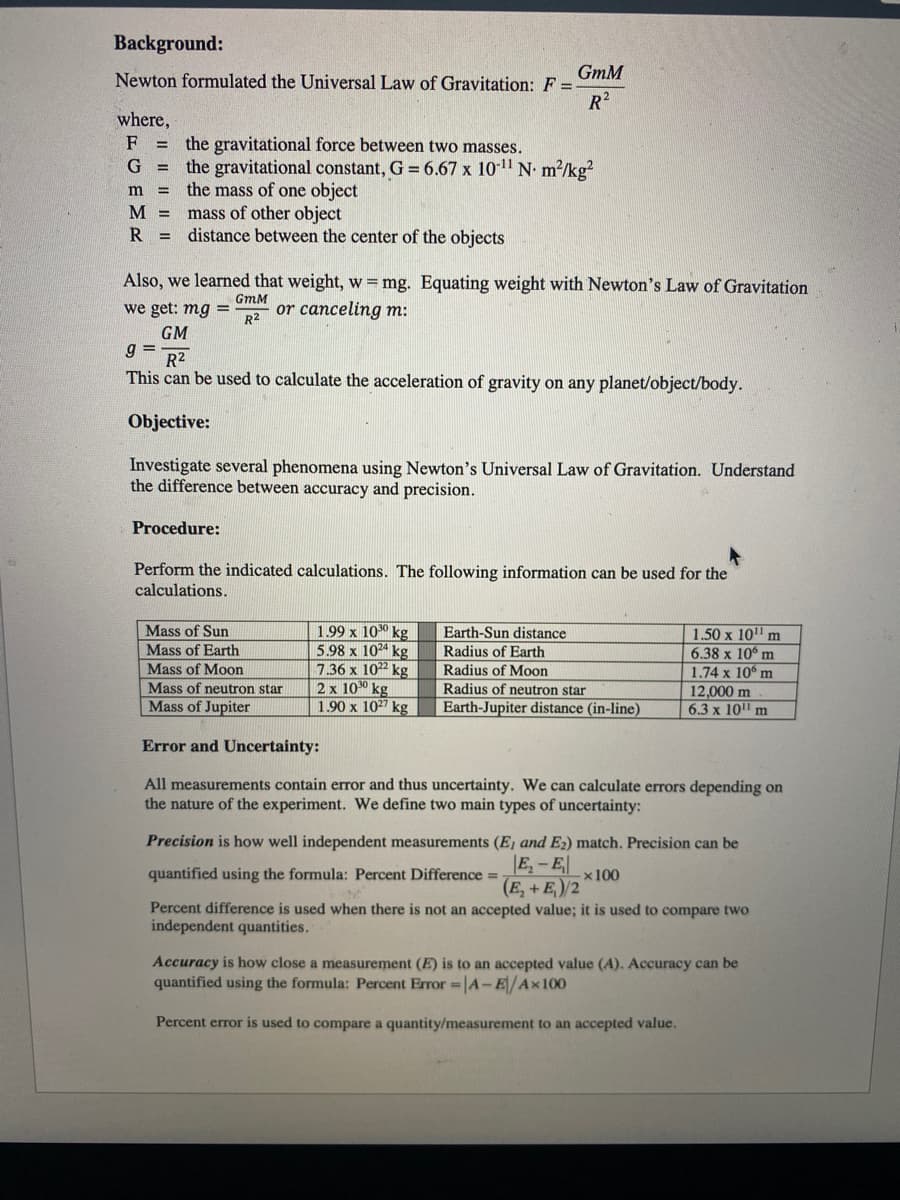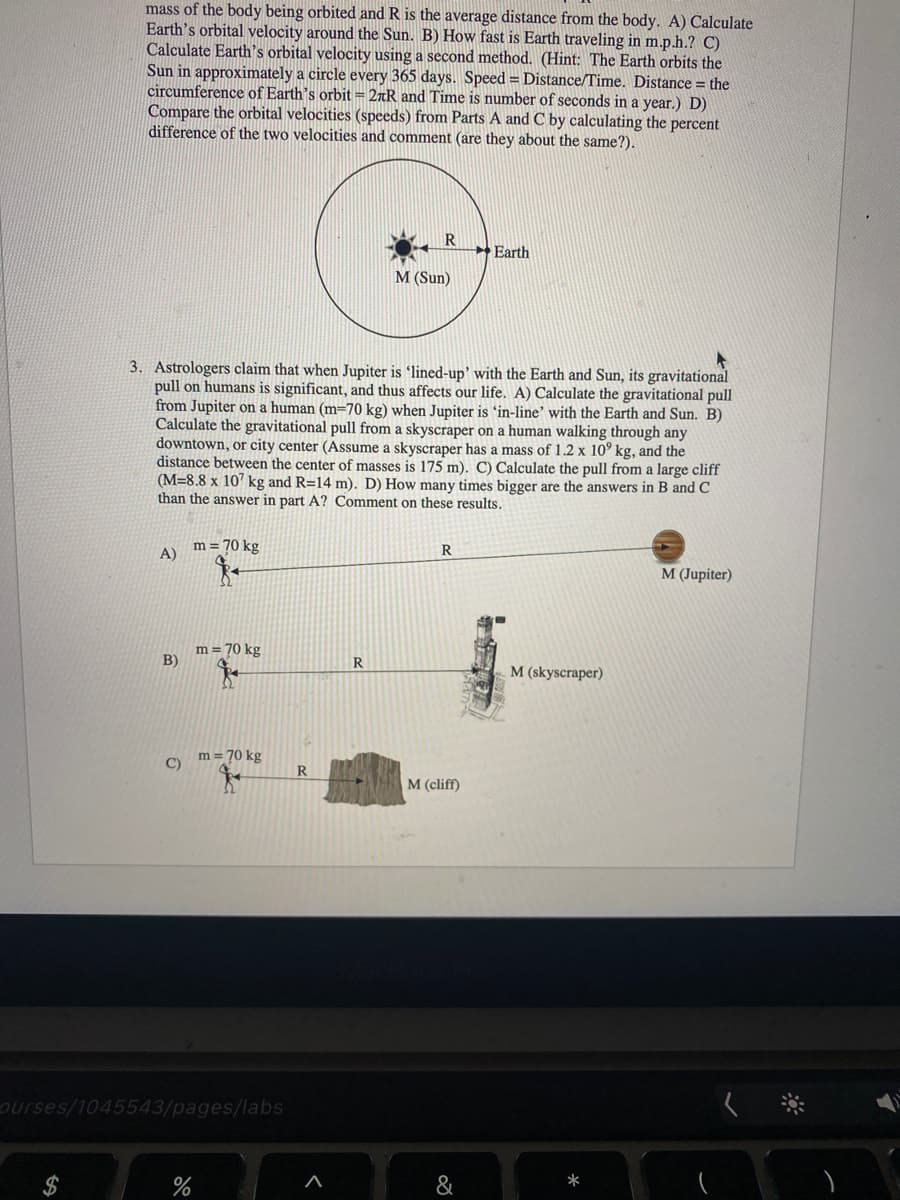3. Astrologers claim that when Jupiter is 'lined-up' with the Earth and Sun, its gravitational pull on humans is significant, and thus affects our life. A) Calculate the gravitational pull from Jupiter on a human (m=70 kg) when Jupiter is 'in-line' with the Earth and Sun. B) Calculate the gravitational pull from a skyscraper on a human walking through any downtown, or city center (Assume a skyscraper has a mass of 1.2 x 10° kg, and the distance between the center of masses is 175 m). C) Calculate the pull from a large cliff (M=8.8 x 10' kg and R=14 m). D) How many times bigger are the answers in B and C than the answer in part A? Comment on these results.
3. Astrologers claim that when Jupiter is 'lined-up' with the Earth and Sun, its gravitational pull on humans is significant, and thus affects our life. A) Calculate the gravitational pull from Jupiter on a human (m=70 kg) when Jupiter is 'in-line' with the Earth and Sun. B) Calculate the gravitational pull from a skyscraper on a human walking through any downtown, or city center (Assume a skyscraper has a mass of 1.2 x 10° kg, and the distance between the center of masses is 175 m). C) Calculate the pull from a large cliff (M=8.8 x 10' kg and R=14 m). D) How many times bigger are the answers in B and C than the answer in part A? Comment on these results.
Principles of Physics: A Calculus-Based Text
5th Edition
ISBN:9781133104261
Author:Raymond A. Serway, John W. Jewett
Publisher:Raymond A. Serway, John W. Jewett
Chapter11: Gravity, Planetary Orbits, And The Hydrogen Atom
Section: Chapter Questions
Problem 44P
Related questions
Question
Question answer #3

Transcribed Image Text:Background:
GmM
Newton formulated the Universal Law of Gravitation: F =
R2
where,
F
= the gravitational force between two masses.
G = the gravitational constant, G = 6.67 x 101" N• m²/kg?
the mass of one object
mass of other object
distance between the center of the objects
m
%3D
M =
R =
Also, we learned that weight, w=mg. Equating weight with Newton's Law of Gravitation
we get: mg =
GmM
or canceling m:
R2
GM
g =
R2
This can be used to calculate the acceleration of gravity on any planet/object/body.
Objective:
Investigate several phenomena using Newton's Universal Law of Gravitation. Understand
the difference between accuracy and precision.
Procedure:
Perform the indicated calculations. The following information can be used for the
calculations.
1.99 x 100 kg
5.98 x 1024 kg
7.36 x 102 kg
2 x 100 kg
1.90 x 1027 kg
Mass of Sun
1.50 x 10" m
6.38 x 10° m
1.74 x 10 m
12,000 m
6.3 x 10 m
Earth-Sun distance
Radius of Earth
Mass of Earth
Mass of Moon
Radius of Moon
Radius of neutron star
Mass of neutron star
Mass of Jupiter
Earth-Jupiter distance (in-line)
Error and Uncertainty:
All measurements contain error and thus uncertainty. We can calculate errors depending on
the nature of the experiment. We define two main types of uncertainty:
Precision is how well independent measurements (E, and E2) match. Precision can be
quantified using
formula: Percent Difference =
E-E
x100
(E, +E)/2
Percent difference is used when there is not an accepted value; it is used to compare two
independent quantities.
Accuracy is how close a measurement (E) is to an accepted value (A). Accuracy can be
quantified using the formula: Percent Error =|A- E|/A×100
Percent error is used to compare a quantity/measurement to an accepted value.

Transcribed Image Text:mass of the body being orbited and R is the average distance from the body. A) Calculate
Earth's orbital velocity around the Sun. B) How fast is Earth traveling in m.p.h.? C)
Calculate Earth's orbital velocity using a second method. (Hint: The Earth orbits the
Sun in approximately a circle every 365 days. Speed = Distance/Time. Distance = the
circumference of Earth's orbit = 2rR and Time is number of seconds in a year.) D)
Compare the orbital velocities (speeds) from Parts A and C by calculating the percent
difference of the two velocities and comment (are they about the same?).
Earth
M (Sun)
3. Astrologers claim that when Jupiter is 'lined-up' with the Earth and Sun, its gravitational
pull on humans is significant, and thus affects our life. A) Calculate the gravitational pull
from Jupiter on a human (m=70 kg) when Jupiter is 'in-line' with the Earth and Sun. B)
Calculate the gravitational pull from a skyscraper on a human walking through any
downtown, or city center (Assume a skyscraper has a mass of 1.2 x 10° kg, and the
distance between the center of masses is 175 m). C) Calculate the pull from a large cliff
(M=8.8 x 10' kg and R=14 m). D) How many times bigger are the answers in B and C
than the answer in part A? Comment on these results.
m = 70 kg
R
A)
M (Jupiter)
m = 70 kg
B)
M (skyscraper)
m = 70 kg
C)
M (cliff)
ourses/1045543/pages/labs
%
&
*
Expert Solution
This question has been solved!
Explore an expertly crafted, step-by-step solution for a thorough understanding of key concepts.
Step by step
Solved in 5 steps

Knowledge Booster
Learn more about
Need a deep-dive on the concept behind this application? Look no further. Learn more about this topic, physics and related others by exploring similar questions and additional content below.Recommended textbooks for you

Principles of Physics: A Calculus-Based Text
Physics
ISBN:
9781133104261
Author:
Raymond A. Serway, John W. Jewett
Publisher:
Cengage Learning

Physics for Scientists and Engineers: Foundations…
Physics
ISBN:
9781133939146
Author:
Katz, Debora M.
Publisher:
Cengage Learning

Stars and Galaxies (MindTap Course List)
Physics
ISBN:
9781337399944
Author:
Michael A. Seeds
Publisher:
Cengage Learning

Principles of Physics: A Calculus-Based Text
Physics
ISBN:
9781133104261
Author:
Raymond A. Serway, John W. Jewett
Publisher:
Cengage Learning

Physics for Scientists and Engineers: Foundations…
Physics
ISBN:
9781133939146
Author:
Katz, Debora M.
Publisher:
Cengage Learning

Stars and Galaxies (MindTap Course List)
Physics
ISBN:
9781337399944
Author:
Michael A. Seeds
Publisher:
Cengage Learning